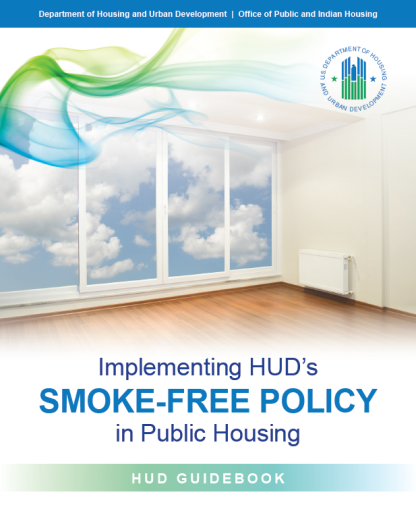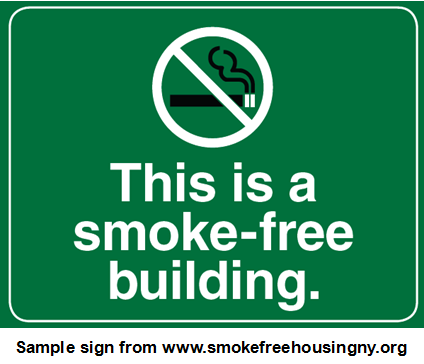The U.S. Department of Housing and Urban Development (HUD) issued a final rule that requires Public Housing Agencies/Authorities (PHA) to adopt and implement a smokefree policy for all public housing properties in order to protect the health and safety of all residents, and to reduce maintenance costs and fire risk. The rule went into effect on February 3, 2017, after HUD issued a proposed rule in November 2015, which was open for public comment for three months.
PHAs provide affordable housing to low-income families, seniors, and people with disabilities. More than 600 PHAs have already implemented smokefree policies, and HUD’s rule will help ensure that all of the 2 million people living in public housing owned by 3,300 PHAs have the ability to breathe smokefree air at home.
What does HUD’s smokefree public housing rule require?
HUD’s rule states that each PHA must implement a smokefree policy within 18 months of the effective date, which means that all policies should be in effect by August 2018. The process of adopting and implementing a smokefree policy should be planned thoughtfully and time should be taken to educate and build support among both building managers and residents.
PHA’s must prohibit smoking in all indoor areas of PHA properties—including all individual units—as well as within 25 feet of buildings. Smoking is defined in the rule as using prohibited tobacco products including hookahs, but not electronic smoking devices (e-cigarettes). Smoking marijuana is not specifically mentioned, but it is not permitted because marijuana use remains illegal under federal law. HUD specifies that PHAs are able to go beyond the minimum required provisions to add further smokefree restrictions, such as covering playgrounds or all outdoor property, or prohibiting the use of electronic smoking devices (e-cigarettes).
HUD’s rule applies to both multi-unit and freestanding (scattered site) public housing properties, but does not cover tenant-based or project-based Section 8 properties, nor tribal housing authorities. While these other types of HUD-funded properties are not required to go smokefree, this rule is an excellent opportunity to reach out to educate and encourage them to consider a smokefree policy.
How can we support the implementation of HUD’s smokefree public housing rule?
Below are some tips for Departments of Health and other public health partners about what can be done to prepare for the implementation of HUD’s smokefree rule. By providing assistance to local PHAs, you can help increase the likelihood of a smooth adoption and implementation of their smokefree policy.
Read Implementing HUD’s Smoke-Free Policy in Public Housing. This guide from HUD provides an excellent overview of the rule and practical steps on how PHAs can implement and enforce smokefree policies. It includes useful examples from PHAs that have already implemented a policy, as well as sample resources that can assist them in the process.
Read HUD’s Guidance on Instituting and Enforcing Smoke-Free Public Housing Policies (Notice PIH-2017-03), which specifies requirements as well as recommendations for PHAs about how they can implement and enforce their policy.
Visit HUD’s website to find out which PHAs are in your area by clicking on your state. The HUD smokefree rule will only apply to the public housing properties that are owned by PHAs. Many PHAs do not have public housing and instead manage other types of HUD-funded affordable housing. For example, California has 104 PHAs but only 55 have public housing. On HUD’s website, the PHAs that have public housing will be marked as Both or Low-Rent under Type in the right-hand column.
Learn about HUD lingo. Housing industry terminology is generally unfamiliar to people working in public health. It is necessary to learn the terminology used by HUD and others in the housing industry in order to understand how housing works and to gain credibility with housing providers. Live Smoke Free Minnesota has an excellent glossary of housing terms to help you become more familiar.
Reach out to your local PHAs. Now is the perfect opportunity to build relationships, assess the smokefree status of PHAs, and learn about their needs. You might already have relationships with some PHAs, and now is an excellent time to reconnect with each one that has public housing. If you don’t already have a connection, which coalition member, community partner, or health department branch might help make introductions? Request an in-person meeting. While some PHAs may be familiar with the guidebook Implementing HUD’s Smoke-Free Policy In Public Housing, consider bringing a hard copy to meetings. Maintain a spreadsheet to track contact information, smokefree status, needs, and useful notes.
Assess your PHAs’ smokefree status and needs. Does each local PHA have a smokefree policy? If yes, how strong is the policy? Are all units in all public housing properties smokefree? Will the policy need to be strengthened to meet HUD’s requirements? If no, have they considered going smokefree? What questions and concerns do they have (cost, tenant resistance, enforcement)? What information and resources do they need? How can your organization support them and/or connect them with additional local assistance? Having difficulty understanding the policy language? Contact us and we will be happy to help. Be sure to check ANR Foundation’s Smokefree Multi-Unit Housing List to see a list of communities and PHAs that have smokefree policies.
Learn how PHA policy changes are made. Typically, a smokefree policy is added to the PHA’s Admissions and Current Occupancy Plan (ACOP), which is updated on an annual basis by the Board of Directors. Your PHAs likely have requirements about notification, meetings, and other procedures that will be helpful for you to learn about as you work to support their policy implementation.
Determine what educational materials are available. Does your health department or other organizations in your state have state-specific materials available about smokefree housing? If so, are these materials written for housing providers as well as for residents? You may not need to create your own resources if state or regional partners have already developed materials. And if you do want to create resources, there’s no need to start from scratch. ANR and many other partners have already created materials that can be use or adapted in your region. View HUD’s Smoke-Free Multifamily Housing Resource Bank and our Suggested Resources to Develop for Your Smokefree Housing Project.
Consider what assistance you can provide to PHAs and building managers.
Providing technical assistance to PHAs and building managers can give them needed direction and confidence with moving forward on their policy. Can you help coordinate a meeting or give a presentation for PHA staff and building managers about preparing for implementation? Can you host a webinar about implementation and enforcement? Can you make smokefree signs available? Can you help managers conduct a survey of residents? Can you connect PHAs with cessation options for their residents?
Consider how you can support residents. Working with residents is an essential part of implementing a smokefree policy, and they need to be engaged early in the process. Encourage PHAs to hold meetings with residents, PHA staff, and the building manager at each building that will be covered by the smokefree policy. Offer to make a presentation at resident meetings. Encourage engaging other community partners who might resonate with residents. These meetings are an important way to allow residents to voice concerns, be heard, and get answers to questions. Can you provide educational materials about the benefits of smokefree housing to residents? Are materials available in various appropriate languages?
Think about cessation opportunities. Cessation is a key part of any successful smokefree policy. What cessation options are available to low-income residents in your state? How can you help connect PHAs with cessation opportunities for their residents? Involve your state QuitLine and other key cessation providers in the conversations. Even if residents chose not to use the cessation opportunities, being offering cessation can help residents feel supported and have a more favorable outlook on the policy.
Think about who your partners are and what resources are available. How can you and your local partners collaborate to collectively support PHAs, building managers, and residents? Start by thinking about who is engaged in your tobacco prevention coalitions and any additional programs that work on housing and/or tobacco issues. Consider whether your coalition adequately represents the community’s housing stakeholders. Local and state tobacco control programs, smokefree housing projects, voluntary organizations, ethnic health networks, fair housing organizations, tenants’ rights coalitions, faith groups, social services groups, asthma organizations, local universities, cessation programs, city/county housing department, etc. Consider if there ways that your programs can work together to support PHAs by making connections and sharing expertise and/or resources.
Foster Peer to Peer learning. Are there PHAs in your state that have already implemented a smokefree policy? Consider reaching out to see if they would they be willing to share their lessons learned, key steps, and advice. Ask if a PHA director or PHA building manager is willing to share their experiences at a training or on a webinar. You could also capture this information as a case study to educate other PHAs, or simply ask them for quotes and tips to be included in a fact sheet.
Plan ahead. This recommendation holds not only for organizations determining how to support their PHAs, but also for encouraging PHAs to utilize the full 18 month implementation phase. Implementing a smokefree housing policy takes time, and experience demonstrates that better results are achieved when implementation and enforcement strategies are well thought out and communicated with all parties involved, including building managers, residents, and support staff. PHAs and building management should be encouraged to start educating and engaging residents from the start of the process, communicate regularly with residents about what the policy will mean for them, how they can comply, and how violations will be addressed, and set an overall expectation of compliance with the policy to help create a healthier living environment for all residents.
Going beyond Public Housing. HUD’s rule is part of the nationwide trend to expand the availability of smokefree housing for residents living in all types of multi-unit properties. Nearly 80 million Americans live in multi-unit housing, approximately 2 million of whom live in public housing and will be covered by HUD’s rule. Thus, there are many people living in multi-unit housing who will still need smokefree coverage. HUD’s rule is an opportunity to increase awareness about the need for everyone in your communities to have a smokefree living environment. Consider reaching out to educate privately-owned affordable and market-rate multi-unit housing providers about the benefits of having smokefree buildings and offering to assist them in adopting a strong policy as part of a community-wide smokefree housing initiative.
More information is available from ANR Foundation at https://no-smoke.org/at-risk-places/homes/ or contact us at info@no-smoke.org or 510-841-3032.
May be reprinted with appropriate credit to the American Nonsmokers’ Rights Foundation.
Copyright 2017 American Nonsmokers’ Rights Foundation. All rights reserved.


